Defining the best monsters in Dungeons & Dragons takes many different forms depending on how you’re looking at them. Are you a DM fed up with your overconfident party’s b.s.? Are you all about the classics with goblins, orcs, and a dragon at the end? Have you played many campaigns and find yourself looking for something different after spending so much time with the classics?
The truth is that few campaigns are going to go through any major portion of The Monster Manual, much less additions from Volo’s, Mordenkainen’s, or any of the array of other enemies showing up in supplemental books. That’s even before the home brews come out. That means there are some truly awesome, funny, or terrifying monsters that never get their fair time on the stage.
This article aims to change that. Whether you’re looking for the best monsters to put an overconfident party back on their toes, alternatives for overly done monsters that show up too often, or that classic big bad that doesn’t get enough love compared to the dragons and liches of the world – we’re here to give you the alternatives that can make things happen.
Read on for lists of fantastic monsters to spice up your next DnD campaign as a GM.
The Best Replacement Monsters in 5E DnD
So how do we decide which monsters are “best?”
In this case we’re breaking down the best underrated monsters in D&D into three categories:
- The best monster bosses that are rarely used
- The best monsters to replace over-used and over-done classics (orcs, goblins, etc)
- The best monsters to bring an over-confident party back to earth without the TPK…probably
This means whatever type of future encounter you’re looking for or dungeon to fill out, you have some pretty incredible options that don’t get enough love and we’re here to fill in those gaps. And then your campaign will stick out and have a chance to hit that rare descriptor of “legendary.”
The Best 5E Monsters to Replace Overused “Classics”
Look, I really enjoy the classics. Tropes are tropes for a reason and while a good TTRPG campaign can involve moral questions and decisions that carry heavy weight with them, sometimes you just want a group of evil enemies to cut through. Good vs. Evil, job well done!
But after your 100th goblin or 200th orc, it can seem kind of, meh. The good news is that there are many very rarely used enemies from the source books that provide interesting twists, turns, and takes on combat at all levels. A different flavor for players to feel like they get a different experience without potentially wiping the party via TPK.
Here are some of my favorites.
Nilbog
Found In: Volo’s Guide to Monsters, p. 113
Oh man do I love the nilbogs. Arguably the first of the “meme” monsters in D&D, nilbog is goblin spelled backwards and these insane jester goblins have the blessing of one of the funniest and strangest low level creatures that can give a party fits without putting them in serious danger. They even have the additional advantage of being able to join a regular goblin raiding party to spice things up.
What makes a nilbog special?
Any player that attempts to harm a nilbog (this includes splash damage – the attack doesn’t have to be direct) must first succeed on a DC 12 charisma saving throw. If they fail, they spend their entire turn praising the glory of the nilbog instead. Considering for most character builds that don’t have Charisma as a casting stat that it’s a dump stat, this becomes fun very quickly.
Add in “Reversal of Fortune” where a nilbog as a reaction can cancel out the damage and regains 1d6 hit points. That means it takes TWO successful hits in one round to actually deal damage to a nilbog, which means there also had to be two successful charisma saving throws.
They have only 7 HP so they are easy to kill if you can actually manage to land the blow, but it’s hilarious how weird a fight can get when the barbarian and fighter are dancing on the front line praising the awesome nilbog, or when the sorcerer realizes he/she needs to make a saving throw for every nilbog affected by a fireball.
They goblins that are possessed by trickster spirits, which makes them fun to roleplay.
Low level, probably one is enough in a small group of goblins or pestering a couple of bugbears. Mid level, you still want to limit it to 3-4 because fights can become very long otherwise.
But as a little bit of hilarious craziness, nilbogs are great. Especially if you let players know the best roleplaying for praising the nilbog gets inspiration.
Bullywugs
Found in: Monster Manual, p. 35
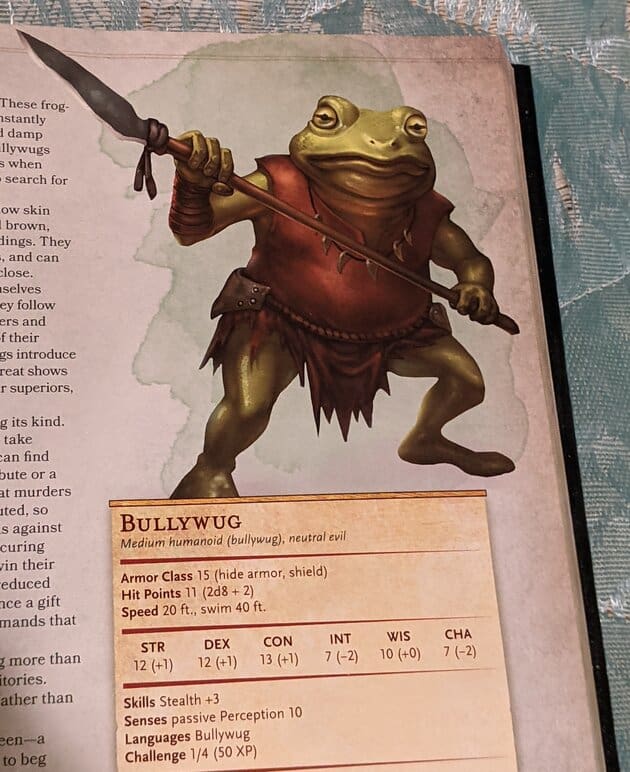
There’s nothing wrong with the classics, but sometimes you want to give experienced players something a little different. For low level parties that are in a swamp area, bullywugs can be a great trade out for early goblins.
They are relatively weak, but are a threat to level 1, 2, or 3 parties. They have some cool little abilities and features that add to the spice of combat and the feeling of suspense – like when one leaps over the front line to land behind them – creating a flank.
They’re fun, they’re different, and since they are an intelligent (albeit low intelligence) creature that has a language, there might be other options for dealing with them other than combat. Like trying to communicate, trading shiny things, or otherwise coming to some sort of agreement that ends in a way other than heavy combat.
Bullywugs are just kind of fun and they throw a very different potential flavor into the early game. They are a great goblin replacement that add an unconventional flavor and give players (and DMs) some potential outs if the dice rolls go really badly and cause the confrontation to go sideways for the party.
Zogre…I mean Zombie Ogre
Found in: Monster Manual, p.315-316

Zombies are fun in theory, though they tend to fall a bit flat in 5E without some homebrew rulings to spice it up. However, when the level 2 party was hunting down a necromancer he just managed to unlock a padlocked door with his last action before the rogue finally hit someone with his crossbow.
The doors were flung open revealing a decaying undead ogre that roared before setting its eyes on food. Zombie ogres (or “Zogres” as the party named them and after laughing we’ve never gone back to calling them anything else) are a nice little twist that add some great flavor to the low level undead scourges with some actual danger.
Zogres hit hard and are a serious threat to a low level party. But zombie ogres also move slowly, are even dumber than when they were alive, and take extra damage from fire.
Because of this combination even most low level parties can handle this challenge if they’re smart about it, but the danger remains. And zombie ogres, or as they forever will be known at our tables as: zogres, add a nice bit of flavor and originality to what is, in too many campaigns, a really boring and banal selection of undead for low level parties.
Gnolls
Found in: Monster Manual p. 162-163
In the same way that bullywugs are a great replacement for the role that goblins play at low level, gnolls are a great replacement for orcs. Nothing wrong with orcs but if you’ve played a lot of D&D and just kind of wish for something different but still need that low to mid-level baddy that can think, fight in groups, and offer challenges: gnolls are the perfect replacement.
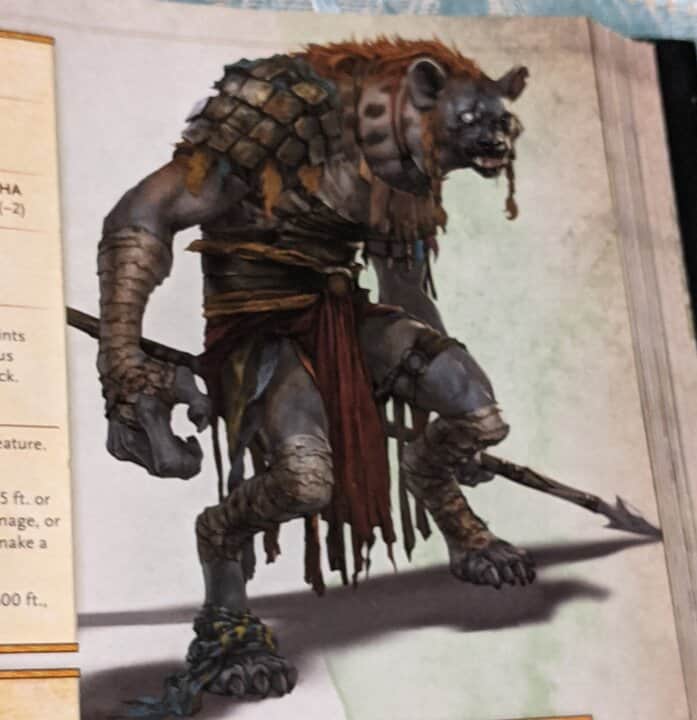
Gnolls are tribe-like, just like orcs, and have a terrifying appearance as humanoid figures that have the head of a hyena yet are bipedal, and can attack and strike with some incredible damage. Matt Mercer used them to incredible effectiveness early on in Season 2 of Critical Role.
They attack in groups, have a terrifying god they worship if you read the lore, and can be deadly close range or used ranged weapons to throw off a party. Add the rampage feature to move faster, further, and attack while the back line can use actual longbows and you have some truly interesting enemies.
The pack leader also is terrifying for a low-level party and can offer some serious danger to a party that is a bit too overconfident of their abilities and push too far.
Add in the ability to act strategically and the animal appearance and if you want a campaign that starts off with a harsh wilderness feeling without the traditional “goblin territory” or “orc territory” feel than a bullywug + gnoll combination can definitely get it done.
The Best 5E Monsters to Create a Serious Challenge
Some monsters are a serious challenge even if they’re not seen as traditional boss fight material. These are some of my favorites for adding genuine danger to an encounter that doesn’t have a big bad at the end.
Mix in to bring home that understanding that this is a dangerous world, and the party needs to remain on guard to avoid catastrophe.
Roper
Found in: Monster Manual, p. 261

Boy this is one you have to be careful with, but it’s a great way to stymie a party that is getting a bit too big for its britches early on. Ropers are one of those enemies that can’t accurately be captured with challenge writing. The best way to deal with them? Massive fireballs in the area that hit your teammates but get rid of the tendrils.
But if your spellcasters are the first ones restrained you’re facing big, high AC, damage-resistant monsters that do insane amounts of damage and can take multiple characters out of a fight as it draws them in for a meal.
You may also have a party that has gone through the cave but taken damage, making the sorcerer or wizard very hesitant to just lob a fireball, especially if they don’t have careful casting.
These monsters are actually scary effective and if you roll high damage on a crit bite – you could conceivably nearly one-shot kill a mid-level character. So don’t use lightly.
Have a “smart” mimic who works with two ropers to pull in unsuspecting party members and that’s a battle that can threaten a potential TPK to even relatively strong mid level parties. So while they can be amazing in combo, it’s really important to make sure you line up the situation carefully to avoid an unwanted TPK.
However, if a party is going “we are god murder hobos” at a mere level 10 or 12…then maybe it’s time to remind them of mortality.
Iron Golem
Found in: Monster Manual, p.170

Ah, the Iron Golem. Also known to us DMs who have suffered through so many campaigns with parties casting 3-4 fireballs a battle round as the anti-fireball underrated bada**. Or something to that effect.
Ah the game was going so well until the sorcerer, wizard, and even the bard all took fireball. Then it’s been “Fireball, fireball, fireball” ever since. Even the best of DMs are going to struggle to come up with a consistent response to this. The Iron Golem is the perfect counter to this common theme, especially if it can be worked in naturally (a gnome tinkerer gone rogue with his warlock brother, for example).
This is a monster that can work as a boss-level type fight even as your party is in-between major plot points. Seriously, this is one of my favorites and can fit here for an experienced 6 person mid-level party, or a relatively high level 4 player party may see it as a boss-level fight.
Why is the iron golem awesome?
Because not only is the iron golem fireproof…but fire HEALS it.

This means if your early fighters got some good hits off, maybe even a crit from the ranger, that fireball not only doesn’t do the job but could undo ALL the damage that had been done by the rest of your party.
The Iron Golem has a 20 AC, hits like a truck, and is immune to fire. This is a tank that can take quite a beating and dish it out, as well. Great for a serious challenge and if you combine it will a decent NPC who can cast magic and react intelligently and this upgrades to good boss fight for even mid to high level character parties.
The iron golem is also a creature that just doesn’t show up that often. Want a gnome city, or a city that hints of steampunk in the world of DnD? The iron golem is a fantastic enemy to bring that feeling and special aesthetic while offering a very different and alien challenge to the party.
Tucker’s Kobolds
Found In: Various online sources, originally from Dragon Magazine Issue 127
This is a fun one that has hit the old school history books of D&D history. Tucker’s Kobolds were an example in early AD&D of how very weak but cunning enemies could use their knowledge of home turf, numbers, and ingenious guerilla tactics to make life a living hell for a much stronger and more advanced group of foes.
These could, in theory, be ramped up be actually scary to big-time parties, but for how D&D has changed and evolved makes me think the easier and more practical setup is making them a decent harassing threat that annoy, harass, and through traps, alchemist’s fire, acid, and sheer numbers give the menacing constant threat for a party not smart enough to book it and GTFO.
I love having a few kobolds appear, seeing the party smirk as they approach, and then stop smiling when they hear me roll 20 d20s behind the screen. “Okay ACs because a lot of crossbow bolts came from all directions, including two crits, as you see firing slots open up in the wall. The barbarian stepped on a pressure plate he failed to notice so I need Dex saves from the entire front row, you hear the sound of breaking glass close by and a loud boom as a draw bar comes down sealing the double doors you entered from from the inside as two kobolds attach thick iron locks to metal to close it in.”
At that point, the terrifying reality of the situation hits and those who know what to expect only add into the absolute chaos that follows as all hell breaks loose.
This is old, old school and a throwback that your players might not appreciate…but can be a whole lot of chaotic fun when done right.
The Best Under-Used 5E Monster Bosses
Oh look, another dragon. Oh wait, we’re underwater and there are storms outside. Gee, I wonder what it might be? A kraken? The lightning dragon of the underwater.
Now in fairness, this isn’t fair. Dragons are awesome and Krakens are terrifying, and these classical mythical monsters were focused in on as big baddies that became boss tropes for a reason. But if you’ve played in a lot of D&D campaigns unless you have a DM who can really put a unique spin on them chances are that you’re, well, kinda over them.
In many of our campaigns it became clear that the most interesting bosses were either demi-gods we had to stat out, insane wizards we had to stat out, or basically characters that had to be custom make to bring something different. And while I love homebrew content…there are some serious boss monsters in the DnD books that just don’t get enough love.
So let’s have at them!
Beholder
Found in: Monster Manual, p. 26
A Favorite of Old Man Callahan’s, this is one area in DnD where I agree with him. The Beholder is an outstanding boss monster that is powerful, terrifying, and potentially lethal even to relatively high level parties, especially if they are forced to fight in its lair and one or two early rolls go the wrong way.
First of all Beholders are just awesome. So let’s take a moment to appreciate them on that standard alone. Second, they use the Z axis. They fly, which gives freedom of movement that lets them mock melee while focusing on ranged combat specialists and spell casters. Their eye beams do so many things and are terrifying.
Oh yeah, and you are almost certainly facing one in its lair. And outside of an Aboleth or Kraken, it’s hard to imagine another lair that you would less want to be in.

The beholder’s randomness adds to the chaos. Maybe the barbarian gets turned to attack the sorcerer. Maybe your cleric is turned to stone. Can the rogue get off a sneak attack with the beholder flying so far away? There’s so much going on here and the fact the lair actions just add in to the chaos and damage, this leads to an enemy that creates something in a fight most mid-high to high level parties have long since forgotten: fear.
In a beholder’s lair you can plan and do your best, but once the colored beams start flying you realize very quickly that you are not in control.
Beholders are a bit different from many other monsters on this list – as they are almost certainly the best known. Yet somehow in so many campaigns they just don’t come up in direct conflict nearly often enough.
Aboleth
Found in: Monster Manual, p.13-14
Really? You’re actually considering taking my advice on this one? Wow. You are one special kind of monster. I like your style. The Aboleth is a truly terrifying creature that, when run correctly, has potential to TPK even a high level party and brings an air of dread to those experienced players who know what they’re dealing with which is well warranted, well earned, and well deserved.
The aboleth is a terrifying creature that is often passed over because, well, the sheer number of TPKs these were responsible for in past editions. They are not nice, and getting to them is just as bad. And the cleric’s gods help you if forced to fight in its underwater lair. You thought a kraken was bad?
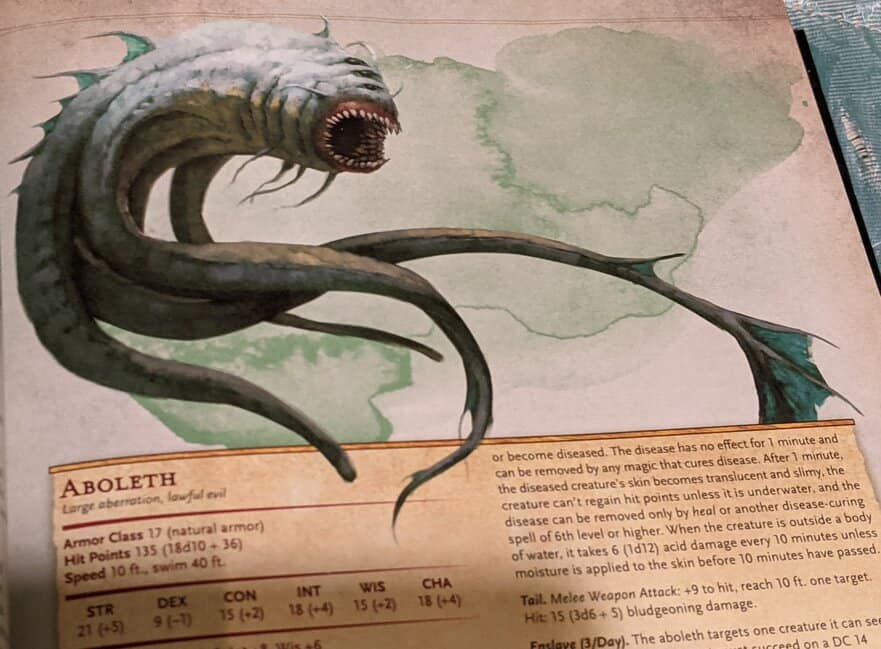
The base stats of an AC of 17 and relatively low HP might not scare you at first glance, but there’s a reason they are terrifying.
First: Considering their age and intelligence/wisdom scores, there’s NO reason for them to ever come out of a lair for a fight. Meaning you are always going to have to deal with them in the lair which makes them that much more dangerous.
The aboleth makes three tentacle attacks per turn, each of which forces a CON save or the player becomes diseased. If there are no 6th level or higher spells after a minute the character takes serious acid damage every 10 minutes or they must be constantly kept wet or suffer damage. This leads to serious issues with healing and potential exhaustion if travel is necessary there, or the player becomes basically and amphibian.
Oh yeah, and there’s a tail attack, too, for four attacks per turn.
There are 3 legendary actions per turn that include extra tail attacks, or the terrifying psychic drain where a charmed PC not only takes massive damage, but heals the aboleth in doing so. Oh and they can target a creature three times with a WIS save that enslaves a PC. They can try to resave every time they take damage, but at that point you’re basically the aboleth’s puppet.
The lair has many ways to cause damage and worse, in a tight cavern with seeming “lake” the lair can be used to start the boss fight before the rest of the party knows there’s a fight, pulling in party members failing a STR 14 saving throw.
Aboleths are just NASTY and when played as an endless ageless and intelligent enemy they are beyond terrifying.
Illithid Colony (aka Mind Flayers)
Found in: Monster Manual, p. 221-222
Not often seen as boss material, they should be. Just a handful of mind flayers can wreak havoc with even a high level party. They have the potential to straight out murder a PC, they have psionic attacks that hit the entire group that no one in your party is resistant to, not even the barbarian, and they are incredibly intelligent beings who can use strategy, have minions, and seek to consume.
A single mind flayer can hit like a truck with one of the types of damage that there is virtually no way to soak, dodge, or ignore. They have deadly solo attacks, can 1 v 1 a player who rolls badly with perma-death and even group AOE attack. Two of these have a change of breaking a mid-level 4 person party.
Add in the minions, the slaves, The Mind Flayer Arcanist if you are a sadistic DM, or just the idea of a whole group of these in one place protecting a hive mind and you are face to face with a terrifying adversary that is the equal of even high level parties.
If you want an experienced group of players at high level to go from cocky dragon slayers ready to ascend to godhood to widened eyed terror realizing how wrong things could go, have them discover a strange otherworldly vessel crashed from another place, holding a small colony of mind flayers. That changes the confidence levels REAL fast.
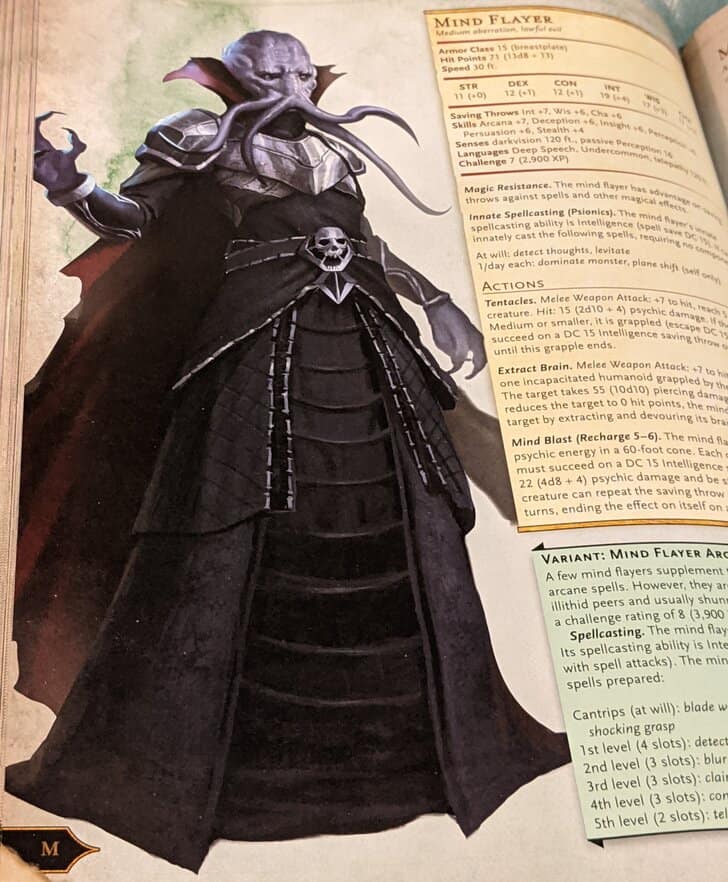
When & How to Customize/Homebrew DnD Creatures
This is something that can be really interesting, but is definitely something that should wait until you have experience as player and DM and really understand the mechanics. This not only lets you build a better customized creature that will offer the party a unique experience and challenge but will help you avoid creating something that inadvertently almost guarantees a TPK on the party.
Unless you’re running a one-shot full of inside jokes for the Twitch stream in which case may I introduce the cupboard revenant.
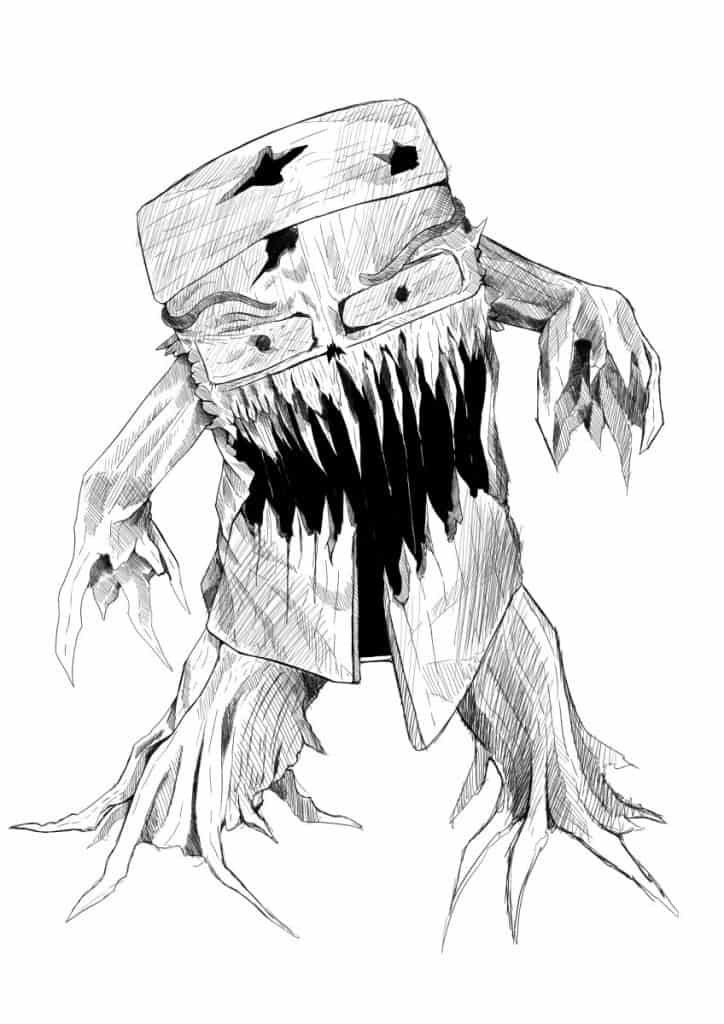
Customizing monsters can be a lot of fun but it shouldn’t be done for the sake of doing something different. If there’s a theme that works great with it and you have BOTH played long enough and DM’ed enough to understand how the systems work then that can be a fantastic time to dip your toes in and see what you can come up with.
But if you DM for more than one group – consider testing it with the group who won’t be seeing it in campaign if they’re willing.
So What Are Your Favorite DnD Monsters?
That list should give you quite a few ideas to spice up the next campaign, or add something extra to whatever campaign you’re in the middle of right now. Whether low level, mid level, or prepping for that all or nothing boss fight, there are plenty of options available that should be able to spice up any campaign.
Other DnD Articles You May Enjoy
- Crossbow Expert Feat 5E
- Charger Feat 5E
- 5E Wizard Vs Sorcerer
- 5E Barbarian Vs Fighter
- Arcane Focus 5E
- Passive Perception Guide

Proud to embrace the locally created moniker of “Corrupt Overlord” from one of the all time great Lords of Waterdeep runs, Shane is one member of the Assorted Meeples crew and will be hard at work creating awesome content for the website. He is a long-time player of board games, one time semi-professional poker player, and tends to run to the quirky or RPG side of things when it comes to playing video games. He loves tabletop roleplaying systems like Dungeons & Dragons, Pathfinder, Werewolf, Fate, and others, and not only has been a player but has run games as DM for years. You can find his other work in publications like Level Skip or Hobby Lark.
